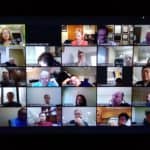The Chicago AGD Presented “The Science & Technology Behind Treating Sleep Apnea – A Roadmap To Lower Stress And Healthier Patients!” by Dr. Jeff Horowitz” Friday March 26th. Dr. Horowitz completed his undergraduate studies at the University of Pittsburg and earned his dental degree from the Medical University of South Carolina. Dr. Horowitz founded the Carolina Center for Sleep Apnea in Conway, South Carolina. He is a fellow in the Academy of General Dentistry, a key opinion leader for Catapult Education, and a member of the American Academy of Dental Sleep Medicine or AADSM. We are so pleased to have this respected international lecturer present the abc’s of sleep apnea important for dental practices to become a part of the “sleep team” of health care providers.
Sleep apnea is a growing field in both dentistry and medicine. There are currently only about 1000 dentists holding diplomate status in the American Board of Dental Sleep Medicine or D.ABDSM, and around 3000 physicians specialized in Sleep Medicine. Pulmonologists, psychologists, pediatricians and ENT physicians are among the doctors eligible for completing a fellowship or specialty in Sleep Medicine. These physicians and dentists are uniquely qualified to diagnose and treat sleep apnea or OSA, respectively. It is estimated nearly 50 million people may suffer from Obstructive Sleep Apnea while only 10% of these patients are currently being treated. This obstruction is primarily located in the upper airway oropharynx. This is why dentists are now regarded as part of the “sleep team” of professionals helping patients with this potentially serious health problem.
Sleep apnea is characterized by snoring, gasping, and frequent sleep interruptions. Many times there is a concomitant reduction in oxygen saturation so many patients become hypoxemic. Every body organ system can be adversely affected by OSA, including our cognitive abilities. Memory, learning, and judgement are impaired when there is a lack of oxygen to the brain and why airline pilots and on-the-road truck drivers are now being routinely screened for OSA.
Dr. Horwitz talked about the technology that is used in screening patients in the dental office including bilateral tomography and CBCT and described the classification system and orthognathic phenotype used in determining who to screen. The primary diagnostic test physicians use to diagnose OSA is the Polysomnogram or PSG. It should be noted here that OSA is a medical problem and can only be diagnosed by physicians and according to the 2015 AASM/AADSM standards of care and the role dentists have in the treatment of OSA, a patient must be “diagnosed and referred to a dentist for treatment of OSA with an oral appliance (OA).” But he stressed dentists play an active role in screening, evaluating and understanding the way oral appliances are used in patients for successful treatment. Care must be taken to know the limitations as well.
Overall, a very interesting seminar. Dr. Horowitz is very experienced in this new, growing and important health field. We thank him for his time and outstanding seminar.
Ivan Valcarenghi, DDS, FAGD, D.ABDSM


